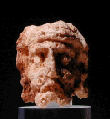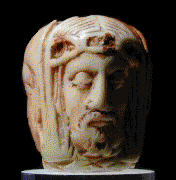

Musée Archéologique de Viuz Faverges |
|
Flat copper axe
from Englannaz : This type of axe was used during the «
Chalcolithic » (or "Copper Age" 2300-2200 B.C.E.).
Interestingly, Ötzi, the Alpine Ice Man who was discovered
on the Similaun Glacier in 1991, was carrying an axe of this
type. Length : 105 mm ; Width : 42 mm. |
|
Necklace of 189
amber beads : It comes from the No 3 man's grave in Saint-Jean
d’Arves (Savoie). The central bead has a diameter of |
|
Series of fine
striated bronze bracelets : Discovered in situ on the
forearms of grave No _ in Saint-Jean d’Arves (Savoie), these
bracelets, worn over the right and left wrists are typical of
the jewelry worn in Alpine cultures at the start of teh second
Iron Age. Date : 450/400 B.C.E. |
|
Pair of triangular
lead earrings. Found in woman's grave No 5 of the necropolis
of Saint-Jean d’Arves (Savoie), they date back to approximately
450/400 B.C.E. |
|
Terracotta statuette : 129 mm high, it can be dated to the First or Second Century A.D.. It is a fairly crude representation of a human being; its expression is as mysterious as its purpose. Mr. J.J. HATT has suggested that it may simply have been made by a potter for his own amusement. |
|
Guttus or Roman baby bottle: the pipette allows a child to suck small quantities of liquid. This type of object is typically found in children's graves of Gallo-Roman times. This particular bottle, a fine example of Allobrogian pottery, was discovered in 1968 in a First-Century context. Like the rest of the pottery found nearby (dishes in particular), it is perfectly preserved and complete. |
|
Bronze dog : The animal is represented standing, with snout extended and ears upright. This statuette, which was found in Viuz-Faverges, dates back to the Second Century A.D.
|
|
|
|
Sheep shears : This tool was used to shear the wool from sheep. This type of shear is still in use today, attesting to the efficiency of its design. It was found
in Viuz-Faverges in a Third-Century A.D. context. |
|
Terracotta canteen
: Found in the peristyle of the Thovey villa in Faverges, it
is round and has a well-formed handle and spout. This type of
object is probably North-African in origin (Tunisia) and can
be dated to the Third Century A.D.. It has a diameter of 270
mm. |
|
Bronze cauldron
: Found during the excavation of theperistyle of the Thovey villa
in Faverges. Beaten from a single large sheet of metal, it bears
witness to the craftsmanship of the gallo-roman bronzesmiths.
An iron band fastened around the rim holds the two iron rings
which were used to hang the cauldron over the hearth. Its shape
is typical of Celtic metalwork, though its context suggests a
Third-Century A.D. date. Its diameter is 570 mm and its height
is 306 mm. |
|
Denarii of Nero,
Hadrian, and Volusian. These three coins come from the trove
discovered in 1971 in a dwelling of Vicus Casuaria. The bronze
pear-shaped vase in which they were found contained 2307 coins,
and was apparently hidden at the time of the invasion of the
Alamans in 259-260. The images on this page include three coins
from the treasure. Above, a drachma of Hardrian (117-138), struck
in Amesus, on the coast of the Black Sea, in the year 131. |
|
The Emperor Nero is represented on a coin which dates to his reign (54-68 A.D.)
|
|
|
|
|


|
|
|